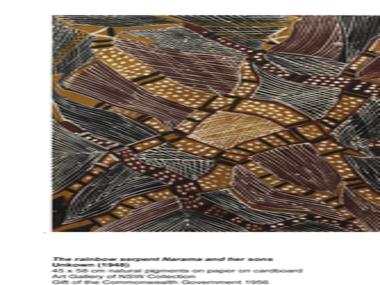MOUNTFORD BARKS GET AN OUTING

The Rainbow Serpent Narama and Her Sons/Unknown
Posted by Jeremy Eccles | 25.03.09
Gallery: Art Gallery of NSW
Dates:
21.03.09
: 03.06.09
Location: The Domain, Sydney
The small showing of barks and works on paper collected by Charles Pearcy Mountford during his American-Australian Scientific Expedition to Arnhemland in 1948 – currently at the AGNSW – raises more questions than it answers.
Which is not necessarily a bad thing.
For the viewer is taxed to think about the images, their making and their collection in a way that the fully-catalogued exhibition of old barks at the MCA recently (They Are Meditating) perhaps did not.
For a start, there's the equivocal Mountford himself. A self-trained ethnologist who'd been sent by the Federal government to talk up Aboriginal art in America, he was invited to lead the 1948 Expedition by the US National Geographical Society and the Smithsonian Institution. A team of 17 spent 7 months at three bases – Groote Eylandt, Yirrkala and Oenpelli. And Mountford's three tomes on the Expedition's researches were definitive in the 50s, but have largely disappeared from currency – a consequence perhaps encouraged by the later legal banning of his book, 'Nomads of the Australian Desert' in the 70s at the behest of Pitjanjatjara people for revealing too much sacred information.
And yet, in 1956, the 171 barks and 104 works on paper collected by the Expedition were distributed – not to anthropological museums, but to 9 institutions in the two countries, including all the State art galleries in Australia. Why was this then perceived, by both givers and recipients, as proper art? A receptive Tony Tuckson was certainly at the AGNSW then; but one suspects the other Galleries would have instantly consigned these works to store-rooms. For this was the peak of Assimilation Time – the Aborigines were supposed to die out, not share their culture with white Australia.
And yet the majority of works on paper at AGNSW show that Mountford saw them as painters in a Western sense – introducing both paper and watercolours, and getting back works that reveal less stylisation and rarrking than works in ochre on bark; though there's certainly no loss of ceremonial subject-matter in a work like the Bunugu Bunumbirr Ceremony from Yirrkala. A Milingimbi Honey Bag image, on the other hand could be a bark.
But the extraordinary Rainbow Serpent Narama and her Sons (pictured) could surely only be a work inspired by the non-traditional possibilities of a different paint and a different surface – taking its complex abstract imagery neatly to the edges of the paper, for instance. And it comes in a suite from Yirrkala which includes the Dhuwa view of an Aboriginal Heaven. Was this missionary influence? Or a genuinely indigenous afterlife?
Narama is joined by two other evil female demons on the walls – which raises fascinating questions about just how far back in Arnhemland's history had there been a matriarchal dominance – as revealed in many myths and stories from the region. For surely only males uncertain of their 'superiority' would portray all the Bad Things around them as female!
So, ironically, it is to the anthropologists – so long rejected for their exclusive rejection of an Aboriginal artistic ethos in favour of painting as evidence of family relationships or ceremonial activity – that one wants to turn to get the most from this under-interpreted exhibition.
By the way, the 60th anniversary of the 1948 American‑Australian Scientific Expedition to Arnhem Land is a fitting time for celebration, re‑evaluation, and renewed collaboration between the individuals, institutions, and countries touched by this formative research venture. In 2009 the Centre for Historical Research at the National Museum of Australia will commemorate this anniversary by hosting ‘Barks Birds & Billabongs: Exploring the Legacy of the 1948 American-Australian Scientific Expedition to Arnhem Land', a symposium that will investigate the expedition’s significant, and often controversial, legacy. This conference will be at the National Museum of Australia, Canberra from 16-20 November 2009. Further information: www.nma.gov.au/barks_birds_billabongs
URL: www.artgallery.nsw.gov.au
Share this:
»  del.icio.us
»
del.icio.us
»  Digg it
»
Digg it
»  reddit
»
reddit
»  Google
»
Google
»  StumbleUpon
»
StumbleUpon
»  Technorati
»
Technorati
»  Facebook
Facebook
Contact Details
Gallery: Art Gallery of NSW
Contact: Cara Pinchbeck - Curator of Aboriginal and Torres Strait Islander Art
Email: artmail@ag.nsw.gov.au
Telephone: +61 2 9225 1700 or 1
Address: Art Gallery Road Sydney Sydney 2000 NSW
Gallery: Art Gallery of NSW
Contact: Cara Pinchbeck - Curator of Aboriginal and Torres Strait Islander Art
Email: artmail@ag.nsw.gov.au
Telephone: +61 2 9225 1700 or 1
Address: Art Gallery Road Sydney Sydney 2000 NSW
Where is the exhibition?
Further Research
Gallery: Art Gallery of NSW
News Tags: American-Australian Scientific Expedition to Arnhem Land | Art Gallery of NSW | Charles Mountford | Groote Eyelandt | National Museum of Australia
News Categories: Australia
Exhibition Archive
- 10.10.17 | TARNANTHI 2017
- 11.08.17 | Natsiaas 2017
- 20.07.17 | APY ART DOMINATES THE WYNNE
- 17.07.17 | Anangu Artist Wins $100,000 Prize
- 14.07.17 | The End of AAMU
- 11.07.17 | ART ACROSS THE COUNTRY
- 11.07.17 | TARNANTHI IN OCTOBER
- 05.07.17 | TJUNGUṈUTJA - from having come together
- 13.06.17 | Ghost-Nets Straddle the World
- 07.06.17 | Grayson Perry Going Indigenous?
- 05.06.17 | Barks Bigger than Ben Hur
- 27.05.17 | NGA QUINQUENNIAL 2017
- 21.05.17 | Blak Douglas Finds Home at the NGA
- 21.05.17 | BRIAN ROBINSON WINS HAZELHURST WOP
- 18.05.17 | PARRTJIMA 2.0
Advertising

